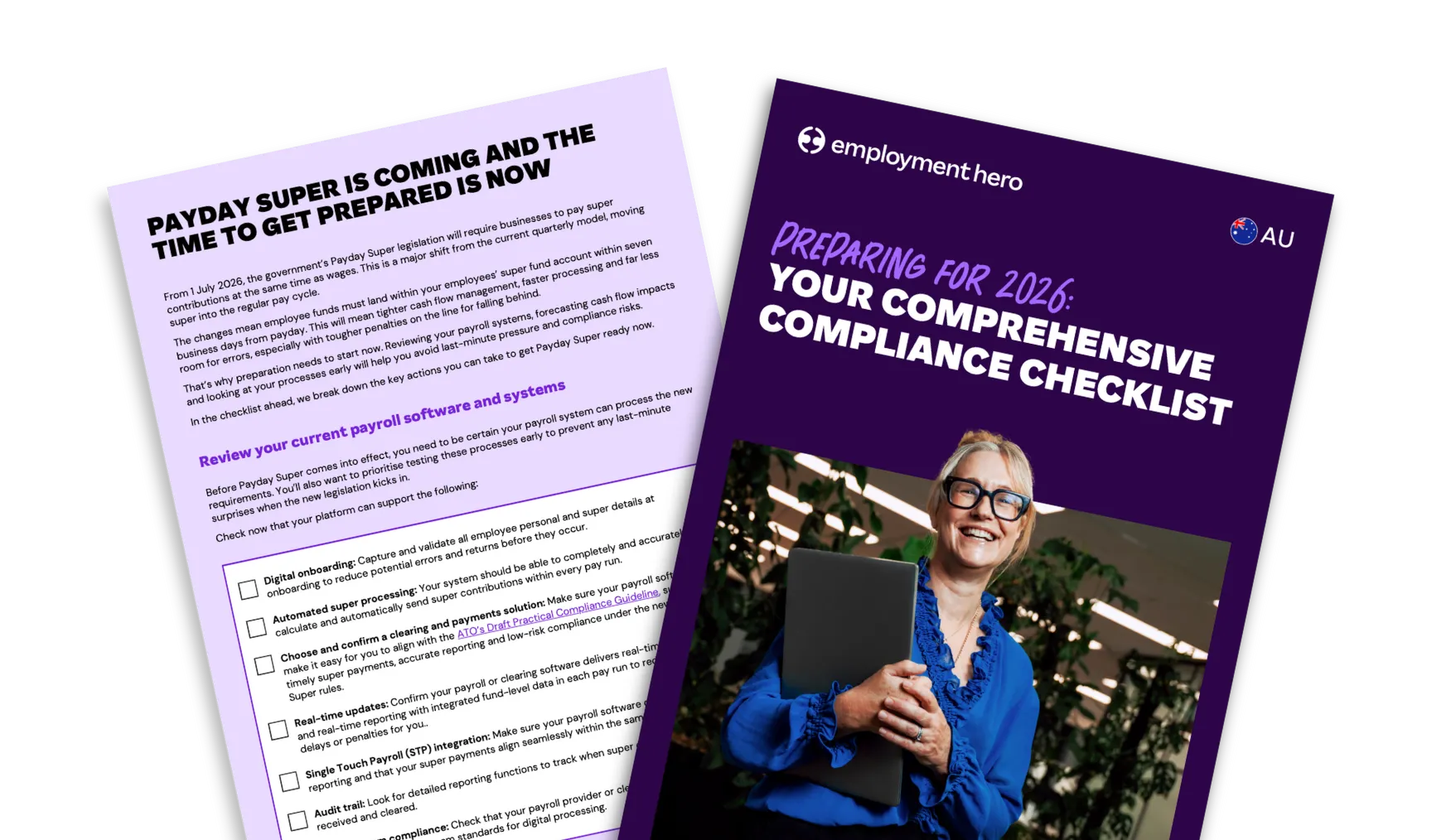Discipline and termination policy template and guide
Published
Discipline and termination policy template and guide
Do right by your business by implementing a discipline and termination policy.
A well-documented discipline and termination policy does more than outline the steps to follow when addressing employee misconduct or underperformance. It also sets a clear standard of behaviour and expectations in your workplace. It helps managers and business owners make consistent, fair and legally defensible decisions when it comes to disciplinary actions or dismissals.
Without a proper policy, disciplinary decisions can feel arbitrary or inconsistent, leading to confusion, disengagement or legal action. A strong policy ensures everyone in your business knows what is expected of them, how concerns will be addressed and what the potential consequences are for repeated or serious issues.
Whether you’re issuing a verbal warning, placing someone on a performance improvement plan or moving toward termination, a clear policy acts as your guide to protect your business.
How can this discipline and termination policy be used?
This free employee discipline and termination can be tailored for your use. These discipline policies have been vetted by our team and are frequently reviewed to ensure they are up to date.
This policy can be used in different scenarios, whether you’re dealing with a poor performer or someone who behaves poorly at work, you need to give your employees every opportunity to respond and improve before you dismiss them.
The objectives of this discipline and termination policy are to, as far as reasonably practicable:
- Set out guidance relating to dealing with poor performance and misconduct in your business
- A step-by-step guide to all procedures that the business needs to adhere to during the termination of an employee
Key takeaway:
A discipline and termination policy helps provide clear guidelines for addressing employee misconduct or underperformance before moving to dismissal.
Having a consistent approach to discipline and termination protects your business and ensures employees are treated with dignity and respect.
Employee termination process and procedure
With a discipline and termination policy in place, employees who are unable to accomplish their duties or are found of serious misconduct in the workplace can be subject to having their employment terminated.
When dealing with the termination of employees, it is important to ensure they are treated fairly. In cases where conflicts arise, referring to our workplace conflict management guide can provide useful strategies for resolution.
Firing an employee is one of the most stressful things you’ll ever have to do as a boss. It’s also something that is very difficult to defend. Make no mistake, if you have made the decision to terminate an employee’s tenure, it’s critical to get all your ducks in a row first and adhere to a strict employee termination procedure.
Whether you’re dealing with a poor performer or someone who behaves poorly at work, you need to give your employees every opportunity to respond and improve before you terminate employment.
Providing corrective action and performance management
If you’re facing the daunting situation of having to fire an underperformer, it’s important not to act rash with your disciplinary action. You need a measured response.
First, take a look at the Fair Work Ombudsman’s best practice guide on managing underperformance
The procedural fairness aspects of the termination process mean you must give the employee every opportunity to lift their game and meet the expected standards. For instances involving more complex behavioural issues, you might find our guide on managing toxic staff highly beneficial.
To keep you on track, here’s a 14-step checklist from the FWO:
Performance management checklist
- Ensure employees clearly understand what is expected of them
- Clearly identify and then assess the problem
- Organise a meeting with the employee to discuss the problem
- Allow the employee to bring a support person to the meeting
- Conduct the meeting in a private, non-threatening location
- Define and explain your concerns to the employee
- Give the employee a genuine opportunity to respond before considering taking action
- Where an employee’s performance is suffering due to the employee’s personal circumstances, refer the employee to professional help like counseling
- Clearly outline the improvement required and the consequences of continued poor performance
- Devise a solution with the employee to improve performance
- Develop an action plan which includes performance improvement milestones and time frames for further review
- Schedule another meeting to review the employee’s performance against the agreed action plan
- Document all discussions, including actions to be taken
- Monitor the employee’s performance and continue to provide feedback
Once you’ve been through this process, if you see no sign of the employee’s performance improvements to the agreed standard you may wish to issue them with a formal written warning. This should set out the areas they need to improve and the fact that if they don’t do so, their future employment will be at risk.
There is no magic number of warnings an employee has to be provided before dismissal can be considered, but if they have been issued a sufficient number of warnings and still have not improved, you may wish to invite them to a formal disciplinary meeting where they are given an opportunity to explain why they should not be dismissed. This is also the process that should be followed when dealing with employee misconduct.
With any meeting where dismissal is discussed, the employee should be allowed to attend with a support person. They should also be given advance notice of the purpose of meeting in writing so they can prepare.
After the meeting has finished, make sure you consider everything the employee raised before taking a decision on whether dismissal is appropriate. If it is, then this should be confirmed to the employee in a further meeting and also in a written termination letter.
It’s also essential that you explain the sudden absence of the terminated employee to their team. You don’t need to go into too many details. But make sure you address the matter with staff promptly to avoid morale-zapping gossip.
Key takeaway:
Employers must follow a step-by-step termination policy that complies with legal requirements, including procedural fairness and proper documentation.
Your disciplinary procedures should include verbal warnings, written warnings, and performance management plans that allow employees a fair chance to improve.
Employee termination procedure for small businesses
For smaller businesses, specifically those with fewer than 15 employees, you are given a little more breathing room by way of the Small Business Fair Dismissal Code. But you still need to be cautious around the employee termination process.
The Code explains:
- When it’s fair to dismiss an employee
- Your responsibilities as an employer
- What you need to prove if your employee makes a claim for unfair dismissal
To qualify as a small business and use the code, calculate the number of employees in your business. Based on a simple headcount of all employees including; full-time, part-time and casual staff who are employed on a regular and systematic basis.
You must also include any employees of an associated entity, including those based overseas.
Download the policy template using the form on the right.
Should an employee be given notice of termination?
The process to terminate an employee’s work contract usually involves a period of notice that states in writing when their employment will end. The length of this period varies, depending on how old the employee is and how long they’ve been working at the company. It is also possible to end employment immediately and make a payment “in lieu” of notice. Casual employees are not entitled to notice periods.
Summary dismissal
In matters where you have found an employee is guilty of serious misconduct, you can dismiss the employee without a notice period as long as you follow a robust disciplinary process and (if relevant) the Small Business Fair Dismissal Code.
In general, serious misconduct applies to the sort of things that you’d report to the police, such as theft, fraud and violence or any conduct that causes a serious risk to your reputation. Serious misconduct also includes serious breaches of occupational health and safety procedures.
Be protected against unfair dismissals
Implement a discipline and termination policy in your workplace now to minimise the risk of unfair dismissals.
Unfair dismissal claims can cost your business time, money, and reputation. One of the best ways to protect yourself is by ensuring that every disciplinary action or termination follows a fair and consistent process, as outlined in your discipline and termination policy.
By documenting expectations, performance issues, warnings, and opportunities given for improvement, you create a clear audit trail. This shows that your business gave the employee a fair chance to address concerns and that dismissal was the last resort.
Unsure if your business is properly protected? Or already managing difficult dismissals? Get in touch with our team, and our HR Advisory experts will help you regain confidence in your business practices.
To download the policy template, we just need a few quick details.
Related Resources
-
 Read more: HR Managers: Don’t just survive the festive season, master it
Read more: HR Managers: Don’t just survive the festive season, master itHR Managers: Don’t just survive the festive season, master it
Make year-end easier: manage leave, payroll, parties and shutdowns with confidence. Get practical tips for Australian SMEs. Download the free…
-
 Read more: Preparing for 2026: Your Compliance Checklist
Read more: Preparing for 2026: Your Compliance ChecklistPreparing for 2026: Your Compliance Checklist
Get your business ready for the 1 July 2026 changes. See practical steps for Payday Super, cash flow planning and…
-
 Read more: Monthly business budget template for employers
Read more: Monthly business budget template for employersMonthly business budget template for employers
Plan your monthly income and expenses with our free monthly business budget template. Download today to track cash flow and…























